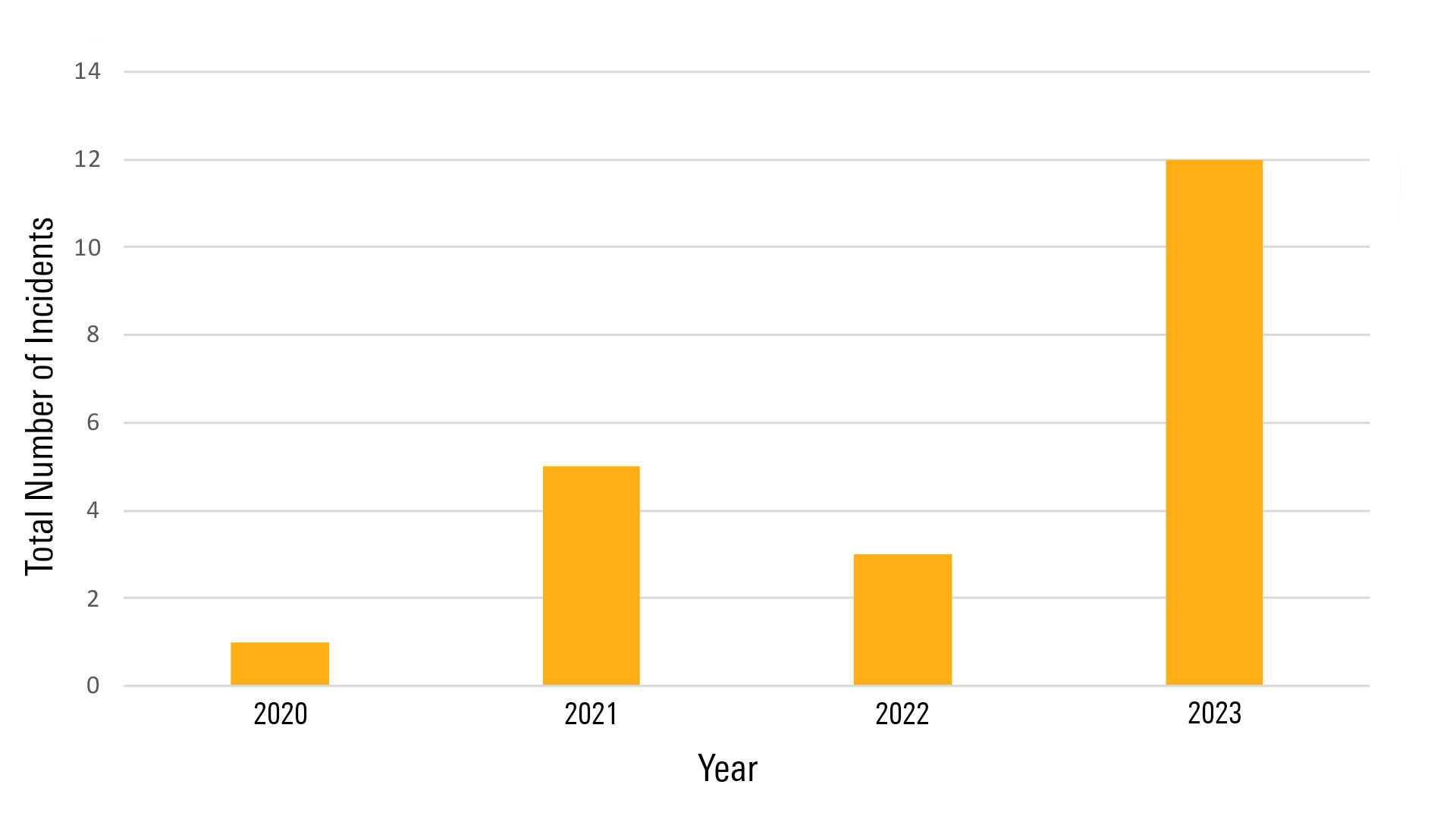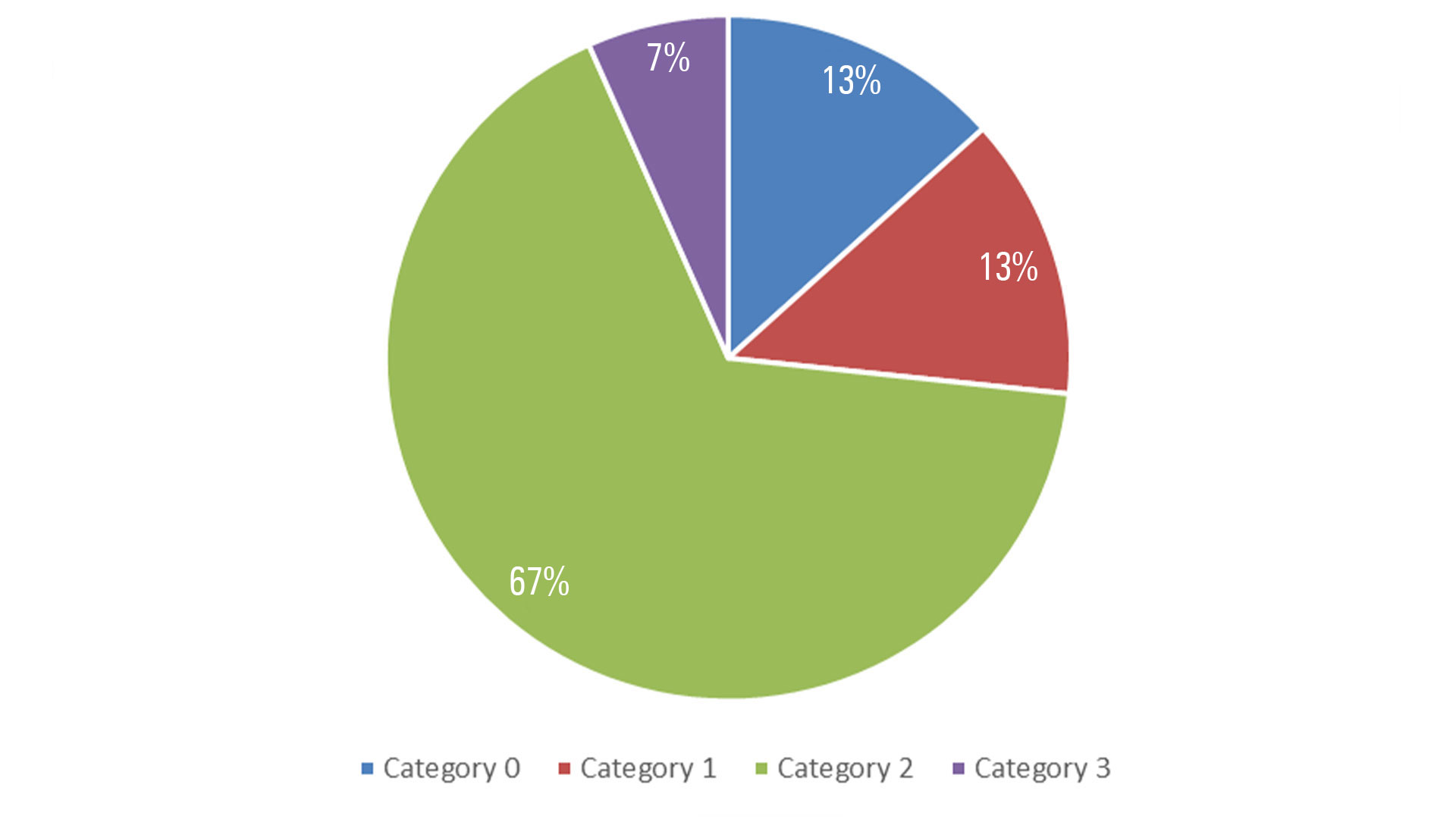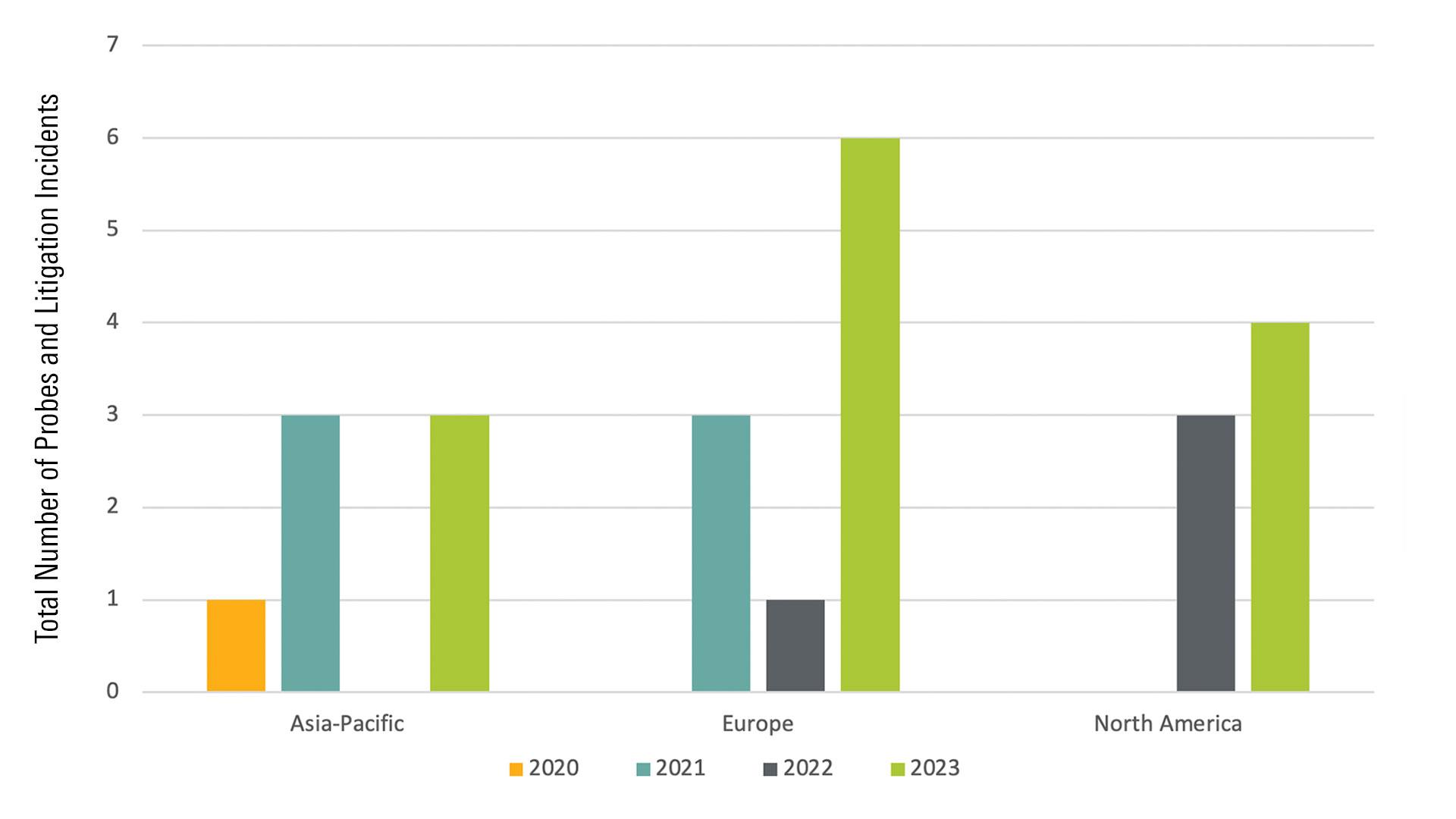The fight against greenwashing is being taken to the courts. An analysis of Morningstar Sustainalytics data shows a significant rise in climate-related probes and litigation, including greenwashing claims against banks over the past three years.1 The data substantiates reports from the Network for Greening the Financial System (NGFS), a network of central banks and financial supervisors that aims to accelerate the green transition. The network identified greenwashing as an emerging risk for the financial sector back in 2021. We are now seeing their predictions come true.2
But why are banks seeing such a dramatic rise in environmental litigation? How severe are the risks for litigation? And how are banks in different regions impacted by this rising challenge? In this article, we’ll be answering these questions as we explore emerging trends in climate and greenwashing litigation.
Banking Industry Exposure to Climate Litigation
According to an analysis of Sustainalytics data for 15 large banks, the number of litigation incidents related to the environmental and carbon impact of products increased twelvefold between 2020 and 2023 (see Figure 1). This can be attributed to their size, their global operations, as well as their role in the economy and the energy transition. Larger banks attract more scrutiny from regulators due to their role in the global economy and their ability to mobilize capital for green financing.
Figure 1. Probes and Litigation Incidents Related to the Environmental and Carbon Impact of Products in the Banking Industry 2020 – 2023

Source: Morningstar Sustainalytics. For informational purposes only.
Additionally, according to the European Central Bank (ECB), universal banks and global systemically important banks in Europe tend to have higher exposure to carbon-intensive sectors. This is because these sectors are dominated by large companies which typically enter financial relationships with larger banks.3 Increased scrutiny has come even as banks have tried to make progress towards sustainability goals.
Increasingly, banks are joining industry-led initiatives in an effort to develop innovative green solutions. They have also committed to mobilizing billions of dollars of capital to fund the energy transition. However, their commitments, actions and sustainable products have attracted skepticism over the credibility of their pledges for green financing and progress made on their transition plans. Based on Sustainalytics data, most lawsuits and probes challenge the implementation of environmental policy and the implementation of climate commitments (e.g., Paris Agreement commitments).
In 2021, for example, an NGO filed a legal complaint against Deutsche Bank, Barclays, Axis Bank, DBS Bank and Emirates NBD Bank with the U.S. Securities and Exchange Commission (SEC) over greenwashing claims related to sustainability-linked bonds.4 These claims could be material for banks in light of the concerns flagged by UK financial regulators over the design of these bonds, such as inadequate incentive to meet sustainability goals, weak targets, and conflicts of interests.5
With such incidences on the rise, it’s important for banks to understand just how significant of an impact they can have on both their bottom lines and reputations.
Greenwashing and Climate Litigation Risks: How Severe Are They?
When examining controversies, such as litigations and probes, Sustainalytics classifies incidents into six categories: Category 0 (no risk to the company), Category 1 (low risk to the company), Category 2 (moderate risk to the company), Category 3 (significant risk to the company), Category 4 (high risk to the company), and Category 5 (severe risk to the company).6
In looking at probes and litigation incidents due to the environmental and carbon impact of products for the 15 banks in our analysis, Sustainalytics categorized most incidences in 2023 as Category 0 (13%), Category 1 (13%), or Category 2 (67%), or zero to moderate risk to the company (see Figure 2). This is because, in most ongoing cases, although a complaint has been filed, it is unclear whether there is legal standing for the complaint and uncertainty whether authorities will open an investigation.
Figure 2. Controversy Rating Categories for Litigations and Probes Related to the Environmental and Carbon Impact of Products in the Banking Industry 2023

Source: Morningstar Sustainalytics. For informational purposes only.
For instance, in 2023 BNP Paribas was sued by NGOs in France over alleged violation of corporate due diligence laws and fossil fuel financing.7 The case is still at an early stage, and it is unclear whether it will move forward with a regulatory investigation. However, if the authorities open an investigation the bank could be exposed to fines. Therefore, the incident is categorized as a moderate risk to BNP Paribas, or Category 2.
A higher risk example comes from a greenwashing case in Canada. In 2023, the Canadian Competition Bureau started an investigation against Royal Bank of Canada (RBC) over claims that the bank made false and misleading statements about its environmental policy, following a legal complaint from an NGO.8 The complaint sought a fine and order against RBC to remove all statements the company made about tackling climate change. The bureau stated that RBC could face a fine up to US$7.2 million (CA$10 million) if found guilty of misleading the public. Due to the increased regulatory and reputation risks, this incident is considered Category 3, or significant risk.
The business risks from greenwashing litigations include costs of damages, fines and legal costs. Moreover, banks with high exposure to carbon-intensive industries may face credit risks in the medium-term.9 Lastly, if a bank is investigated for greenwashing, and particularly if it is found liable, the reputational risk is significant. It can negatively impact its credibility, deposit growth,10 reputation as a leader in sustainable financing, and eventually its competitive position in the sustainable financing business. However, when it comes to both risks and consequences, not every region is the same.
Regional Differences in Exposure to Climate Litigation
In 2023, greenwashing in the financial sector became a central concern for U.K. and EU regulators. In May, the European Banking Authority (EBA) noted that greenwashing risks were on the rise for banks.11 The following month, the U.K. Financial Conduct Authority (FCA) raised questions about the credibility and transparency of sustainability-linked loans.12
The regional breakdown below (Figure 3) indicates that EU and U.K. banks face the most scrutiny over their environmental policies, net-zero pledges and financial instruments such as sustainability-linked bonds. According to the EBA, criticisms of greenwashing have amplified towards EU companies in particular. Moreover, financial and banking institutions in the region account for a higher share of alleged greenwashing cases compared to other regions.13
Figure 3. Regional Differences in Probes and Litigation Incidents Related to the Environmental and Carbon Impact of Products in the Banking Industry 2020 - 2023

Source: Morningstar Sustainalytics. For informational purposes only.
Since EU banks face greater scrutiny, they tend to also have their disclosures and strategy challenged by various stakeholders. This is partly due to the EU’s sustainable finance policies and regulations being more advanced than other regions and countries. This increases the likelihood of being challenged or criticized for potential non-compliance.14
North American banks are also facing increasing accusations of greenwashing, partly due to enforcement of the SEC’s new disclosure and labelling regulation. The U.S. is a highly litigious market, with greater potential for litigation as climate reporting requirements evolve. In addition to these considerations, Canada’s new Guidelines on Climate Risk Management come into effect in 2024.15 The rules apply to all domestic systemically important banks (i.e., a bank that could disrupt the economy should it fail) and are expected to have an impact on greenwashing litigations in the region.
Climate Litigation Outlook
Many of the current cases in the recent swath of climate litigations for banks are still at an early stage. But if these cases succeed, legal risk may become a much larger concern as we approach 2030, a milestone year for transition plans to net zero by 2050. It could spark new litigation from NGOs, clients, investors, and large shareholders that are concerned with a misalignment between a bank’s stated strategy and its actual progress against its net-zero targets.
This will be of particular concern in the EU where transition plans are set to become mandatory with the Corporate Sustainability Reporting Directive, the proposed Corporate Sustainability Due Diligence Directive, and the recent Capital Requirements Directive proposal. These new EU regulations could trigger further class action climate litigation for banks, as it would provide additional legal base for litigants’ claims. As a result, legal and reputational risks are expected to increase in the medium-term for large banks.
Interested in learning more about how you can address greenwashing risks? Read our latest guide, Seeing Through the Green: A Guide to Greenwashing Risks for Asset Managers, featuring strategic insights from investment professionals to help you spot greenwashing and mitigate your risks.
References
- Data is according to Morningstar Sustainalytics Ratings universe, which comprises approximately 5,000 large and medium market cap investable issuers in developed and emerging markets.
- Network for Greening the Financial System. 2021. Climate-Related Litigation: Raising Awareness About a Growing Source of Risk. November 2021. https://www.ngfs.net/sites/default/files/medias/documents/climate_related_litigation.pdf
- European Central Bank. 2023. The Road to Paris: stress testing the transition towards a net-zero economy. September 2023. https://www.ecb.europa.eu/pub/pdf/scpops/ecb.op328~2c44ee718e.en.pdf
- Hay, J. 2021. Banks Hit By ‘Fraud’ Complaint to SEC Over Adani SLB Coal Links. Global Capital. October 21, 2021. https://www.globalcapital.com/article/297sitz2boxhpl0ffm29s/sri/banks-hit-by-fraud-complaint-to-sec-over-adani-slb-coal-links
- Financial Conduct Authority. 2023. FCA Outlines Concerns About Sustainability-Linked Loans Market. June 2023. https://www.fca.org.uk/news/news-stories/fca-outlines-concerns-about-sustainability-linked-loans-market
- Morningstar Sustainalytics. 2023. Controversies Research: Methodology. https://www.sustainalytics.com/docs/knowledgehublibraries/default-document-library/sustainalytics_controversies-research_methodology.pdf?sfvrsn=2494e4c5_1
- Fairfax, J., Gupta, A. 2023. First Climate Lawsuit Against a Commercial Bank: NGOs Take Legal Action Against BNP Paribas for Funding Fossil-Fuel Development. April 27, 2023. https://www.osler.com/en/resources/regulations/2023/first-climate-lawsuit-against-a-commercial-bank-ngos-take-legal-action-against-bnp-paribas-for-fund#:~:text=The%20NGOs%20are%20ultimately%20demanding,groups%20chose%20litigation%20over%20dialogue.
- Kalegha, M. 2023. The Royal Bank of Canada’s Climate Policy Has Come Under Close Scrutiny From Its Stakeholders. October 2023. Institute for Energy Economics and Financial Analysis. https://ieefa.org/resources/royal-bank-canadas-climate-policy-has-come-under-close-scrutiny-its-stakeholders
- European Central Bank. 2023. The Road to Paris: stress testing the transition towards a net-zero economy. September 2023. https://www.ecb.europa.eu/pub/pdf/scpops/ecb.op328~2c44ee718e.en.pdf
- Homanen, M. 2018. “Depositors Disciplining Banks: The Impact of Scandals.” City University London - The Business School, PRI Association. December 11, 2018. https://papers.ssrn.com/sol3/papers.cfm?abstract_id=3293254
- European Banking Authority. 2023. EBA Progress Report on Greenwashing Monitoring and Supervision. May 31, 2023. https://www.eba.europa.eu/sites/default/files/document_library/Publications/Reports/2023/1055934/EBA%20progress%20report%20on%20greewnwashing.pdf
- Network for Greening the Financial System. 2021. Climate-Related Litigation: Raising Awareness About a Growing Source of Risk. November 2021. https://www.ngfs.net/sites/default/files/medias/documents/climate_related_litigation.pdf
- European Banking Authority. 2023. EBA Progress Report on Greenwashing Monitoring and Supervision. May 2023. https://www.eba.europa.eu/sites/default/files/document_library/Publications/Reports/2023/1055934/EBA%20progress%20report%20on%20greewnwashing.pdf
- Ibid.
- Office of the Superintendent of Financial Institutions. 2023. OSFI issues new Guidelines on Climate Risk Management. March 2023. https://www.osfi-bsif.gc.ca/Eng/osfi-bsif/med/Pages/b15-nr.aspx





